Intermediate Sex in Virginia Woolf’s Orlando
Palabras clave:
Androgyny, Art, Duality, Gender, Novel, Sexual Identity, Transformation.
Resumen
The literary genres used by several criticsto describe Virginia Woolf’s work, Orlando,published in 1928, include: religious allegory,fable, detective novel, doppelgänger literature,Scottish diabolical tales or the Gothic novel.It is still debated whether it is a sciencefiction story. However, the principal themeis the sexual identity of the protagonist, whocrosses an ‘ageless time’, transforming hissex and sexuality throughout the journey ofhis/her soul. This is a clear rejection of thestructure of Victorian novels, in which malecharacters dominate and female charactersare scarce. Orlando was born a man and then,with the passing of the centuries–from 1600,the last years of Queen Elizabeth I, until the20th century, in the royal political context ofEngland, that of the Suffragettes, when hebecomes a woman and especially in writer.Despite what it has been barely mentioned,this novel is not sexist. As a matter of fact, thepurpose of the work is to expose the needs ofa lady of the Elizabethan era, the male andfemale stumbling blocks of Victorian societyand the obstacles inherent to the obsessionsof the self, where language is decisive for themarking of times.According to Woolf, the sexual differenceis given by education, but it does not intend topromote male-female duality, but to redefinefemininity, while proclaiming that a mind mustbe androgynous.Descargas
La descarga de datos todavía no está disponible.
Publicado
2023-08-29
Sección
Artículos
Derechos de autor 2023 Revista Lasallista de Investigación

Esta obra está bajo licencia internacional Creative Commons Reconocimiento-NoComercial-SinObrasDerivadas 4.0.











